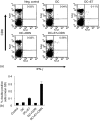CpG-ODN-stimulated dendritic cells act as a potent adjuvant for E7 protein delivery to induce antigen-specific antitumour immunity in a HPV 16 E7-associated animal tumour model
- PMID: 15096191
- PMCID: PMC1782454
- DOI: 10.1111/j.1365-2567.2004.01851.x
CpG-ODN-stimulated dendritic cells act as a potent adjuvant for E7 protein delivery to induce antigen-specific antitumour immunity in a HPV 16 E7-associated animal tumour model
Abstract
We previously reported that both E7 and CpG-oligodeoxynucleotide (ODN) are required for protecting animals from human papillomavirus (HPV) 16 E7-associated tumour challenge. Here we investigate dendritic cells (DC)-based approach in this protection. In the study, we isolated bone marrow-derived DC and stimulated DC with E7 and ODN. In vitro stimulation of DC with E7 plus ODN resulted in more production of interleukin-12, as compared to that with E7 or ODN alone. Further injection with E7+ODN-stimulated DC resulted in more significant tumour protection, as compared to stimulation with E7 or ODN alone. We further evaluated the levels of immune responses induced by DC stimulated with E7+ODN. We observed little enhancement of E7-specific antibody and T helper cell proliferative responses by E7+ODN stimulation, as compared to E7 stimulation. However, there was some enhancement of interferon-gamma (IFN-gamma) production from CD4+ T cells and a more significant production of IFN-gamma from CD8+ T cells by E7+ODN stimulation, as compared to E7 stimulation alone. This was consistent with intracellular IFN-gamma staining levels of CD8+ T cells. Tumour protection further appeared to be mediated by CD8+ T cells, as determined by in vivo T-cell depletion. Thus, these data suggest that upon ODN stimulation DC might function as a potent adjuvant for E7 protein delivery for induction of protective cellular immunity against HPV E7-associated tumour challenge.
Figures







Similar articles
-
Both antigen optimization and lysosomal targeting are required for enhanced anti-tumour protective immunity in a human papillomavirus E7-expressing animal tumour model.Immunology. 2005 Oct;116(2):255-66. doi: 10.1111/j.1365-2567.2005.02219.x. Immunology. 2005. PMID: 16162274 Free PMC article.
-
Both E7 and CpG-oligodeoxynucleotide are required for protective immunity against challenge with human papillomavirus 16 (E6/E7) immortalized tumor cells: involvement of CD4+ and CD8+ T cells in protection.Cancer Res. 2002 Dec 15;62(24):7234-40. Cancer Res. 2002. PMID: 12499264
-
[Dendritic cells present particulate E7 protein of human papillomavirus and induce strong immunity].Zhonghua Yi Xue Za Zhi. 2004 Jun 2;84(11):932-6. Zhonghua Yi Xue Za Zhi. 2004. PMID: 15329282 Chinese.
-
Cellular immunity against DNA tumour viruses: possibilities for peptide-based vaccines and immune escape.Biochem Soc Trans. 1995 Aug;23(3):692-6. doi: 10.1042/bst0230692. Biochem Soc Trans. 1995. PMID: 8566445 Review. No abstract available.
-
Potential strategies utilised by papillomavirus to evade host immunity.Immunol Rev. 1999 Apr;168:131-42. doi: 10.1111/j.1600-065x.1999.tb01288.x. Immunol Rev. 1999. PMID: 10399070 Review.
Cited by
-
Combined stimulation of IL-2 and 4-1BB receptors augments the antitumor activity of E7 DNA vaccines by increasing Ag-specific CTL responses.PLoS One. 2013 Dec 31;8(12):e83765. doi: 10.1371/journal.pone.0083765. eCollection 2013. PLoS One. 2013. PMID: 24391824 Free PMC article.
-
Co-administration of carcinoembryonic antigen and HIV TAT fusion protein with CpG-oligodeoxynucleotide induces potent antitumor immunity.Cancer Sci. 2008 May;99(5):1034-9. doi: 10.1111/j.1349-7006.2008.00760.x. Epub 2008 Feb 24. Cancer Sci. 2008. PMID: 18294279 Free PMC article.
-
Both antigen optimization and lysosomal targeting are required for enhanced anti-tumour protective immunity in a human papillomavirus E7-expressing animal tumour model.Immunology. 2005 Oct;116(2):255-66. doi: 10.1111/j.1365-2567.2005.02219.x. Immunology. 2005. PMID: 16162274 Free PMC article.
-
Umbilical cord blood-derived dendritic cells loaded with BGC823 tumor antigens and DC-derived exosomes stimulate efficient cytotoxic T-lymphocyte responses and antitumor immunity in vitro and in vivo.Cent Eur J Immunol. 2014;39(2):142-51. doi: 10.5114/ceji.2014.43713. Epub 2014 Jun 27. Cent Eur J Immunol. 2014. PMID: 26155115 Free PMC article.
-
CpG oligodeoxynucleotide as immune adjuvant enhances photodynamic therapy response in murine metastatic breast cancer.J Biophotonics. 2014 Nov;7(11-12):897-905. doi: 10.1002/jbio.201300072. Epub 2013 Aug 7. J Biophotonics. 2014. PMID: 23922221 Free PMC article.
References
-
- Steinman RM. The dendritic cell system and its role in immunogenicity. Ann Rev Immunol. 1991;9:271–6. - PubMed
-
- Banchereau J, Steinman RM. Dendritic cells and the control of immunity. Nature. 1998;392:245–52. - PubMed
-
- Mayordomo JI, Zorina T, Storkus WJ, Zitvogel L, Garcia-Prats MD, DeLeo A, Lotze MT. Bone marrow-derived dendritic cells serve as potent adjuvants for peptide-based antitumor vaccines. Stem Cells. 1997;15:94–103. - PubMed
-
- Celluzzi CM, Falo LD. Physical interaction between dendritic cells and tumor cells results in an immunogen that induces protective and therapeutic tumor rejection. J Immunol. 1998;160:3081–85. - PubMed
-
- Verthelyi D, Kenney RT, Seder RA, Gam AA, Friedag B, Klinman DM. CpG oligonucleotides as vaccine adjuvants in primates. J Immunol. 2002;168:1659–63. - PubMed
Publication types
MeSH terms
Substances
LinkOut - more resources
Full Text Sources
Other Literature Sources
Research Materials
